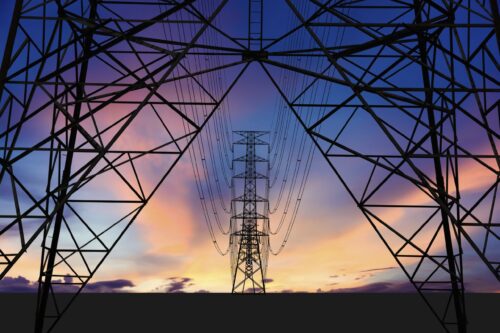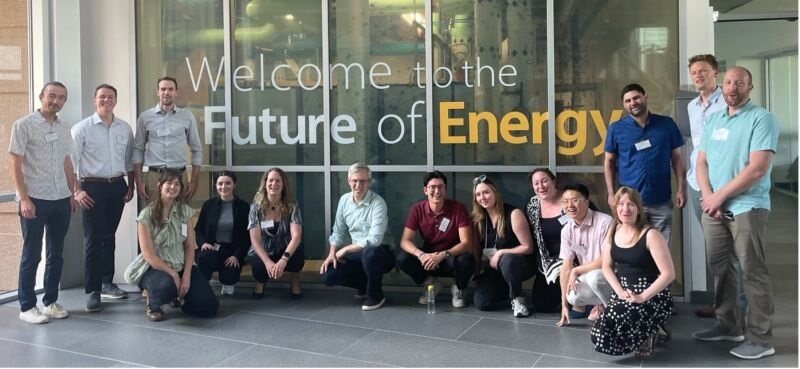
Waiting in Queue: RMI’s Solutions to the Gridlocked US Power Sector
RMI is helping to modernize grid infrastructure, reduce interconnection delays, and ensure the grid can support a clean energy transition.
Key Insights
-
- The US electrical grid faces significant challenges due to the projected increase in power demand.
- RMI is leading efforts to optimize and expand the grid through both short-term fixes, like grid-enhancing technologies (GETs) and clean repowering, and long-term solutions, including workforce development and policy advocacy.
- RMI is helping to modernize grid infrastructure, reduce interconnection delays, and ensure the grid can support a clean energy transition.
- Key partnerships and collaborative efforts are central to RMI’s strategy, helping to drive impactful change across the country.
Today’s US electrical grid looks less like an organized grid and more like an unfinished puzzle. Fortunately, as we plan for growing power demand, RMI emerges as a leader in the pursuit of solutions. With near-term stopgaps to optimize existing grid infrastructure and long-term solutions to grow the grid, build workforce capacity, and promote policy that encourages transmission planning among utilities, RMI is putting the pieces together.
Multifaceted Challenges
The US grid faces incredible challenges. Industry forecasts predict that electricity demand will grow significantly, driven by AI data centers, industrial expansion, and the rise of electric vehicles and heat pumps. Fortunately, on the generation side, vast numbers of clean energy projects have asked to connect to the grid to help meet any rise in demand. Unfortunately, sluggish interconnection processes are delaying the urgently needed generation, with more than 2.6 terawatts (TW) of clean energy projects languishing in the interconnection traffic jam.
How You Can Help
We need big ideas to shift to clean energy and bold partners who support our mission to make it happen. With your support, we will build a grid that can affordably and reliably support a carbon-free power sector by 2035 and achieve net-zero economy-wide emissions by 2050. Make a gift today »
That far exceeds the 1.25 TW of electricity generation currently on the US grid. Why the long wait? New projects looking to connect to the grid must undergo a series of complex impact studies before they can connect. This can take up to five years. There is also a lack of electric transmission to carry the power from clean energy projects to where that energy will be used. Simply put, the model is inefficient and not designed for the energy transition. But RMI is helping change that.
Short-Term Fixes
Maximizing Grid Efficiency: RMI is working with partners to leverage cutting-edge grid-enhancing technologies (GETs) to streamline interconnection capacity now. GETs are innovative technologies that act as energy efficiency solutions for the grid. They can adjust the carrying capacity of transmission lines to reflect real-time conditions, re-route power around congested areas, and optimize power flows. We’re working with utilities and businesses in PJM, the largest grid operator in the country, to modernize and expedite interconnection procedures, a vital step in the journey toward a sustainable energy future. We have published or contributed to multiple reports on interconnection and GETs, providing evidence for the value of GETs in enhancing interconnection and transmission planning at the Federal Energy Regulatory Commission (FERC), the White House, and in PJM stakeholder meetings to make real changes.
Transmission Defined
Power transmission is the movement of large amounts of electricity from a generating plant to an electrical substation. The lines that connect these locations are called a transmission network. This is different from the local wiring that connects substations to customers, known as distribution. Together, the transmission and distribution networks are part of the electrical grid, which delivers electricity to users.
"The sheer scale of the PJM market makes effective environmental advocacy exceptionally difficult,” says Abraham Silverman of the Ralph O’Conner Sustainable Energy Institute at Johns Hopkins University. Silverman has worked with RMI on removing regulatory bottlenecks to the clean energy transition as general counsel at the New Jersey Board of Public Utilities, as a director at the Center on Global Energy Policy at Columbia University, and now in his role at Johns Hopkins University.
RMI has tackled this challenge with its unique brand of technical sophistication and convening expertise and has been an indispensable resource for PJM stakeholders and regulators.
Connecting Clean Energy to the Grid Faster and Cheaper: The lengthy interconnection process slows the expansion of our energy systems during a crucial time for growth. But utilities can bypass the process by siting new clean generation at the same point of interconnection as existing or retiring generators. Using the existing fossil assets’ interconnection rights can cut the time down to less than one year. This clean repowering, or “the express lane of energy reinvestment,” offers the potential for 250 GW of new renewable energy projects without transmission upgrades and translates to an average savings of US$12.7 billion a year for the next ten years. New RMI research and analysis show the interconnection processes and Inflation Reduction Act incentives that enable this opportunity and the geographies with the most potential.
Long-Term Solutions
Planning Power Transmission: On May 13, 2024, FERC released Order 1920, a landmark rulemaking requiring each of the transmission planning regions in the United States to undergo long-term transmission planning. Order 1920 tackles regulatory hurdles that are slowing the deployment of transmission lines needed to deliver affordable, reliable electricity and prevent power outages as energy demand increases. RMI’s articles, submitted comments, and presentations helped influence this transformational policy.

"Our research shows that electric transmission infrastructure can bring massive economic benefits to states and communities while enabling an affordable and reliable energy transition,” says RMI Principal Chaz Teplin, who leads RMI’s work on transmission in the United States.
While regional grid operators have made some progress in updating their transmission planning processes, many can benefit from a more robust and long-term approach. Across the United States, this is where RMI comes in. In the west, where transmission planning is especially fragmented, updated processes for planning and paying for transmission could bring massive economic opportunities. RMI research found that Western states are on the cusp of numerous multi-billion-dollar opportunities, brought by both new energy investments and energy cost savings, that rely on expanded regional transmission. And in the east, RMI is deeply engaged with PJM, supporting the development of Order 1920 compliance by leading a coalition of 16 organizations in collaborative strategy design and implementation.
Transmission's Role in Reducing Costs for an Emission-Free Western Grid
RMI research found that states with clean energy standards, including California, Colorado, Nevada, New Mexico, Oregon, and Washington, can significantly reduce their energy costs by collaborating with their neighbors. The most expansive planning could lead to cost savings of over 30 percent compared with building out generation only within a state.
What's Next?
Transmission lines in the United States can take more than 15 years to plan, permit, and build. In the meantime, short-term fixes like GETs and clean repowering are critical. Unfortunately, there is no one simple trick to planning and implementing an accelerated transmission buildout. Federal and state policymakers and regulators need to improve the incentives to build transmission, push diverse stakeholders to agree to pay for it, and accelerate the speed at which we site and permit lines without sacrificing input from communities or the protection of critical lands.
Moving forward, we need to better understand how clean energy, supported by a larger transmission system, will help to affordably keep the lights on, even with load growth. Luckily, the facts support clean energy’s role — but also make it clear we will need to operate tomorrow’s grid more flexibly than today’s. We must also engage large industrial customers as we define grid solutions. These customers, with their large point source loads, bring both special challenges and exciting opportunities. RMI is working to clarify how the grid can keep up with the loads these customers bring, both in the near term and through longer-term transmission planning.

RMI Transmission Fellows (2024-25)
Building Professional Capacity: RMI is training the next generation of transmission professionals through our recently launched transmission fellowship, imparting the skills and knowledge needed to accelerate and advance transmission buildout in the context of a clean energy future. We are also convening partners around shared strategies to improve interconnection and expand US transmission capacity.
Our Partners
Central to RMI's success are our strategic partnerships and collaborations, including NRDC, Earthjustice, Sierra Club, MAREC Action, Advanced Energy United, Americans for a Clean Energy Grid, our corporate partners at ZEROgrid, and others. We are also grateful to Bloomberg Philanthropies, and other anonymous funders for their philanthropic support, without which this progress would not be possible.